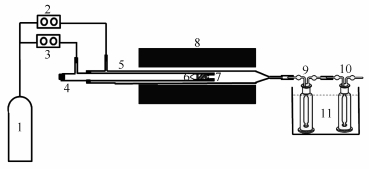Co-combustion characteristics of municipal solid waste with coal gangue and its HCl emission
-
摘要: 利用热重分析仪对城市生活垃圾与煤矸石单独及混合燃烧特性进行了研究,并采用高温管式炉燃烧装置考察了PVC、NaCl及MSW与煤矸石混烧过程中HCl的排放规律。结果表明,在煤矸石中掺烧部分MSW可有效改善煤矸石的燃烧特性,尤其是脱挥发分和着火特性。综合考虑燃烧特性变化,建议MSW掺混比例为20%。PVC与NaCl掺混比较低时,煤矸石可抑制PVC燃烧过程中HCl的析出,会显著促进NaCl中HCl的析出;当掺混比增大时,上述作用逐渐减弱。MSW与煤矸石混烧时,会促进HCl的析出,增大烟气中HCl的浓度。当掺混比为10%时,HCl排放浓度达到56.22 mg/m3,已超过中国国家标准,必须采取相应脱氯措施。Abstract: Co-firing of municipal RDF and coal gangue in existing coal gangue power station is a potential treatment way of municipal solid waste and coal gangue. The co-combustion characteristic of municipal solid waste (MSW) and coal gangue was investigated by thermogravimetric analyzer. The HCl emission in co-combustion of coal gangue with PVC, NaCl and MSW were also studied using a high-temperature tube furnace combustion system. The results show that the combustion characteristic of coal gangue can be improved obviously with blending of MSW, especially for devolatilization and ignition characteristics. In consideration of combustion characteristics, the MSW blending ratio of 20% is suggested. When the blending ratio of PVC or NaCl is low, the existence of coal gangue can inhibit the release of HCl in PVC while promote the release of HCl in NaCl. As the increase of blending ratio, the effect decreases gradually. In co-combustion of MSW and coal gangue, the release ratio and concentration of HCl is increased. When the MSW blending ratio is 10%, the HCl emission concentration is 56.22 mg/m3 which exceeds the national standard. Hence, the dechlorination measurement should be considered.
-
Key words:
- municipal solid waste /
- coal gangue /
- co-combustion /
- hydrogen chloride /
- chlorine source
-
表 1 原料的特性分析
Table 1 Ultimate and proximate analyses of raw materials
Proximate analysis wad/% Ultimate analysis wad/% QHHVdb/(MJ·kg-1) M A V FC C H N S Cl MSW 1.25 19.52 70.40 8.83 47.26 6.33 0.93 0.37 0.73 21.16 Coal gangue 3.52 45.66 21.57 29.25 36.57 2.63 0.55 2.06 0.01 14.07 表 2 MSW与煤矸石混烧时HCl的排放特性
Table 2 HCl emission characteristic in the co-combustion
Fuel HCl release ratio /% HCl emission concentration c/(mg·m-3) experimental calculated Coal gangue 100 100 10.82 10 MSW 66 58 56.32 20 MSW 55 55 84.88 MSW 53 53 288.62 -
[1] 中国统计年鉴[Z].北京:中国统计出版社; 2006-2015.China Statistical Yearbook[Z]. Beijing:China Statistics Press, 2006-2015. [2] ZHANGD Q, TANS K, GERSBERG RM. Municipal solid waste management in China:Status, problems and challenges[J]. J Environ Manage, 2010, 91(8):1623-1633. doi: 10.1016/j.jenvman.2010.03.012 [3] ZHOU H, MENG A H, LONG Y Q, LI Q H, ZHANG Y G. A review of dioxin-related substances during municipal solid waste incineration[J]. Waste Manage, 2015, 36:106-118. doi: 10.1016/j.wasman.2014.11.011 [4] 赵吉睿, 张骥, 刘佳泓.垃圾焚烧过程中二噁英的生成与控制[J].环境科学与技术, 2014, 37(S2):101-104. http://www.cnki.com.cn/Article/CJFDTOTAL-FJKS2014S2023.htmZHAO Ji-rui, ZHANG Ji, LIU Jia-hong. Synthesis and reduction of dioxin emissions in waste incineration process[J]. Environ Sci Technol, 2014, 37(S2):101-104. http://www.cnki.com.cn/Article/CJFDTOTAL-FJKS2014S2023.htm [5] LECKNER B. Co-combustion-A summary of technology[J]. Therm Sci, 2007, 11(4):5-40. doi: 10.2298/TSCI0704005L [6] ZHAO Y, XING W, LU W J, ZHANG X, CHRISTENSEN T H. Environmental impact assessment of the incineration of municipal solid waste with auxiliary coal in China[J]. Waste Manage, 2012, 32(10):1989-1998. doi: 10.1016/j.wasman.2012.05.012 [7] XIAO H M, MA X Q, LIU K. Co-combustion kinetics of sewage sludge with coal and coal gangue under different atmospheres[J]. Energ Convers Manage, 2010, 51(10):1976-1980. doi: 10.1016/j.enconman.2010.02.030 [8] 张月军, 张桂英, 胡亦工.煤泥、煤矸石混烧在循环流化床锅炉中的应用[J].能源技术, 2007, 28(3):189-190. http://www.cnki.com.cn/Article/CJFDTOTAL-LYJI200703022.htmZHANG Yue-jun, ZHANG Gui-ying, HU Yi-gong. The application of mixed coal silt and coal gangue combustion in CFB[J]. Energy Technol, 2007, 28(3):189-190. http://www.cnki.com.cn/Article/CJFDTOTAL-LYJI200703022.htm [9] ZHOU C C, LIU G J, FANG T, LAM P K S. Investigation on thermal and trace element characteristics during co-combustion biomass with coal gangue[J]. Bioresource Technol, 2015, 175:454-462. doi: 10.1016/j.biortech.2014.10.129 [10] 陈正华, 王雪茜, 孙军.城市垃圾与煤混合燃烧特性分析[J].节能技术, 2015, 33(6):522-525. http://www.cnki.com.cn/Article/CJFDTOTAL-JNJS201506009.htmCHEN Zheng-hua, WANG Xue-qian, SUN Jun. Analysis of urban waste and coal combustion characteristic[J]. Energy Conserv Technol, 2015, 33(6):522-525. http://www.cnki.com.cn/Article/CJFDTOTAL-JNJS201506009.htm [11] BAXTER L. Biomass-coal co-combustion:Opportunity for affordable renewable energy[J]. Fuel, 2005, 84(10):1295-1302. doi: 10.1016/j.fuel.2004.09.023 [12] JIN Y Q, LU L, MA X J, LIU H M, CHI Y, YOSHIKAWA K. Effects of blending hydrothermally treated municipal solid waste with coal on co-combustion characteristics in a lab-scale fluidized bed reactor[J]. Appl Energy, 2013, 102:563-570. doi: 10.1016/j.apenergy.2012.08.026 [13] 王宪红.动力用煤混烧生物质燃烧特性及污染物排放特性研究[D].济南:山东大学, 2010.WANG Xian-hong. Study on the combustion and pollutant emission characteristics of steam coal blent with biomass[D]. Jinan:Shandong University, 2010. [14] KUPKA T, MANCINI M, IRMER M, WEBER R. Investigation of ash deposit formation during co-firing of coal with sewage sludge, saw-dust and refuse derived fuel[J]. Fuel, 2008, 87(12):2824-2837. doi: 10.1016/j.fuel.2008.01.024 [15] 李香排.典型垃圾组分HCI排放和脱除的基础研究[D].杭州:浙江大学, 2004.LI Xiang-pai. Basic studyof emissionand controlofHCI on incinerating of typical MSW components[D]. Hangzhou:Zhejiang University, 2004. [16] MATSUDAA H, OZAWAA S, NARUSEA K, ITOA K, KOJIMAB Y, YANASEC T. Kinetics of HCl emission from inorganic chlorides in simulated municipal wastes incineration conditions[J]. Chem Eng Sci, 2005, 60(2):545-552. doi: 10.1016/j.ces.2004.07.131 [17] BOONSONGSUP L, IISA K, FREDERICK W J. Kinetics of the sulfation of NaCl at combustion conditions[J]. Ind Eng Chem Res, 1997, 36(10):4212-4216. doi: 10.1021/ie9603225 [18] GB18485-2014, 生活垃圾焚烧污染控制标准[S].GB18485-2014, Standard for pollution control on the municipal solid waste incineration[S]. [19] 李晓东, 杨忠灿, 严建华, 陆胜勇, 倪明江, 岑可法.垃圾焚烧炉氯源对氯化氢和二噁英排放的影响[J].工程热物理学报, 2003, 24(6):1047-1050. http://www.cnki.com.cn/Article/CJFDTOTAL-GCRB200306043.htmLI Xiao-dong, YANG Zhong-can, YAN Jian-hua, LU Sheng-yong, NI Ming-jiang, CEN Ke-fa. Effects of chlorine on HCl and PCDD/Fs emission in a MSW incinerator[J]. J Eng Thermophys, 2003, 24(6):1047-1050. http://www.cnki.com.cn/Article/CJFDTOTAL-GCRB200306043.htm -





 下载:
下载:






